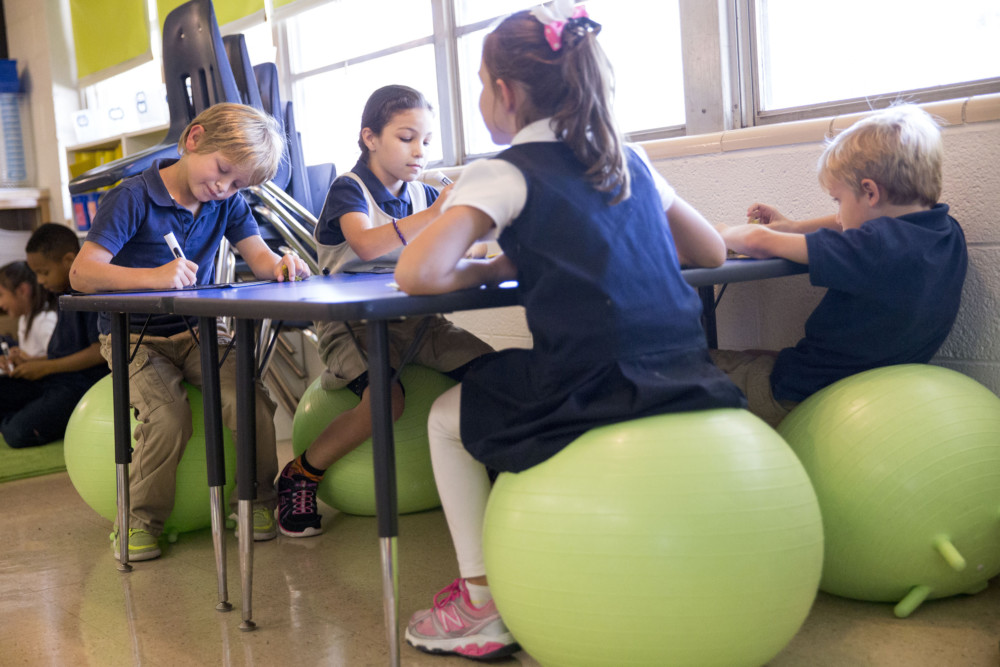By Nanette Light
The Dallas Morning News
WWR Article Summary (tl;dr) Despite the lack of research, some teachers say wobble chairs and bouncy balls can be helpful for students, especially those with ADHD tendencies.
DALLAS
Peek inside Jennifer Cass’ second-grade classroom and you won’t see kids sitting on desk chairs in neat rows.
Some gently bounce on stability balls. Others rock back and forth on plastic wobble chairs that move like spring animals on a playground. Some sit cross-legged on pillows around a low table. The rest lounge on their stomachs on plush bath mats.
Second-grader Qualyon Perkins said his favorite seat is the “bouncy ball.”
“It helps me because when I get wiggly, I don’t have to act crazy. I can just bounce or wobble,” he said.
It’s called flexible seating, and Cass is among several Hexter Elementary teachers who have converted their classrooms with hopes to improve students’ focus and allow them to choose how they learn best.
The evidence isn’t there yet, but the teachers say they see a difference.
“I have a lot of students who like to fidget or move while they work, and regular chairs don’t allow them to do that,” said Cass, who teaches math and science at the Dallas ISD school. “Wobble chairs allow them to move around while they learn.”
Cass said she ditched traditional chairs altogether after noticing most of her students last year didn’t sit in them to do their work, opting instead for bean bag chairs and the floor.
“Why do I have all these desks and chairs in here if no one is using them? They don’t like them, so I got rid of them,” she said.
She said her students get to choose seating based on where they learn best, and there are rules for the new seats, like both feet on the ground and no spinning.
“So it’s not necessarily which one is the most fun. It’s where do you learn best,” Cass said.
The equipment isn’t cheap. A KORE wobble chair, which comes in rainbow colors, sells for nearly $70 on Amazon. According to the company, it can strengthen core muscles and the rocking motion can be calming and organizing for the brain, helping kids pay attention.
Principal Jennifer Jackson said the district didn’t foot the bill for Hexter teachers. Many of them sought donations, ranging from over $600 to over $2,000, on the nonprofit website DonorsChoose.org. More than 20 Dallas-area teachers are among roughly 3,000 pending requests from across the country on the site for flexible seating.
“As we learn more about how our minds and bodies are all connected, how it’s one unit, I think we’re going to see more of it,” Jackson said of flexible seating.
A 2015 study by researchers at the University of California, Davis MIND Institute, an international research center that studies neurodevelopmental disorders, found that fidgeting for children with attention-deficit/hyperactivity disorder may actually help them think.
“Parents and teachers shouldn’t try to keep them still. Let them move while they are doing their work,” Julie Schweitzer, director of the UC Davis ADHD Program and the study’s senior author, said in a news release.
But as far as she knows, whether wobble chairs and other flexible seating helps hasn’t been studied.
“However, it is a very ripe area for exploration,” Schweitzer said in an email. She said the benefits and the costs to the child and the overall classroom environment should be tested.
Despite the lack of research, teachers say wobble chairs and bouncy balls can be helpful for students, especially those with ADHD tendencies.
While many students were excited about the new seats on the first day of school, not everyone likes to wobble or bounce.
Ella Greenman, a second-grader in Cass’ class, prefers a floor pillow to the wobble chairs and bouncy balls, saying it’s easier for her to focus.
“The pillow is squishy. Sometimes it’s hard to work and bounce,” she said.
Caroline Harris, who teaches second-grade reading language arts and social studies at Hexter, replaced desk chairs with a classroom set of wobble stools this year after spotting them in other classrooms. But she kept a few stationary stools around a table for kids who want to stay still.
“They don’t have to sit on a wobble seat,” she said.
And teachers say the repetitive moving isn’t for all educators. The wobble chairs have been a hurdle for substitute teachers used to stationary chairs, Harris said.
“Having someone come in who’s not familiar with them and doesn’t necessarily know what’s going on or why we have them, that’s been a challenge.”
Just like the workplace has changed, think standing desks and stability balls instead of chairs, classrooms are adapting to how students work best.
“We all see the same things: kids wanting to stand or wanting to move around in their chairs,” said Shannon Bowden-Veazey, a third-grade teacher at Hexter. “This gives them the opportunity to do that.”
Bowden-Veazey instigated flexible seating at Hexter when she brought 13 stability balls into her classroom last year after noticing kids leaning in their desk chairs, balancing on the chairs’ back legs.
She can’t say for sure whether it’s helped academically but said she notices students staying seated who, in the past, would roam the room.
“It gives kids a different way to deal with energy or even some anxiety they’re having in their lives,” Bowden-Veazey said.
A teacher for more than 20 years, she’s noticed kids have a harder time focusing than they did a decade ago. She blames it on a variety of factors such as technology and nutrition.
“It’s gotten worse. They can’t sit,” Bowden-Veazey said.














































































































































































































































































































































































